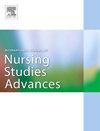护士轮班模式、人员配备及其与感知工作量的关联:多中心数据的序列分析
IF 3.1
Q1 NURSING
International Journal of Nursing Studies Advances
Pub Date : 2025-09-12
DOI:10.1016/j.ijnsa.2025.100420
引用次数: 0
摘要
虽然轮班工作在医院是不可避免的,但一些轮班模式和人员配备水平对护士工作量的影响大于其他轮班模式和人员配备水平,从而影响护士的健康、护理质量和患者安全。尽管工作量在护理实践中很重要,但关注护士工作时间表、人员配备水平和感知工作量的研究很少。本研究的目的是描述急症护理医院护士轮班工作模式的关键特征,并调查轮班工作模式和人员配备水平与感知工作量的关系。方法:本研究是对在瑞士26家急症护理医院进行的一项观察性、横断面、多中心研究的二次分析。来自158个单位的注册护士完成了调查,调查内容包括护士人员配置、工作环境和护理质量。我们使用序列数据分析来可视化护士在过去七天的工作时间表,并确定轮班特征和过渡。聚类使用最优匹配允许我们分组护士与相似的轮班序列和确定轮班模式。计算观察到的超出预期的患者与护士比率(包括患者的视力测量)来评估人员暴露。感知工作量用nasa任务负荷指数测量。使用线性混合模型来探索确定的轮班工作模式,人员配备和感知工作量之间的关系。结果对1962名注册护士进行调查分析。序列分析鉴定出732个不同的序列,形成3个不同的移位模式簇。倒转、快速返回和连续工作超过5天的情况很少见。工作量感知平均为66.5分(可能范围为6-120分)。人员编制低(β=3.1, 95% CI[0.5-5.6])、最后一班加班(β=8.8, 95% CI[7.2-10.4])、前七天加班天数较高(β=3.9, 95% CI[1.3-6.3])、工作天数(β=6.4, 95% CI[2.5-10.1])、最后一班工作为白班(β=3.8, 95% CI[1.8-5.8])和较长的轮班长度(β=1.4, 95% CI[0.5-2.2])与较高的感知工作量相关。结论本研究强调了人员配备和调度实践对护士感知工作量的贡献。为了减少护士的工作量和提高医疗保健绩效,正如先前的研究表明的那样,决策者必须越来越优先考虑人员配备和日程安排的决定。研究结果表明,避免或减少加班、减少轮班长度和增加人员配置可能是减少感知工作量的有效策略。进一步的研究将受益于使用电子花名册、实时人员配置措施和反复评估护士的工作量感知来分析轮班模式。摘要护士主观工作量受轮班模式和人员配置的影响。减少加班时间、缩短轮班时间和优化人员配置可能会减少工作量。本文章由计算机程序翻译,如有差异,请以英文原文为准。
Nurse shift patterns, staffing and their association with perceived workload: Sequence analysis of multicentre data
Introduction
Although shift work is inevitable in hospitals, some shift patterns and staffing levels are suggested to influence nurses’ workload more than others, which in turn can impact nurses’ health, quality of care, and patient safety. Despite the importance of workload in nursing practice, studies focusing on nurses’ work schedules, staffing levels and perceived workload are rare. The aims of this study were to describe key characteristics of nurses’ shift work patterns in acute care hospitals, and to investigate the association of shift work patterns and staffing levels with perceived workload.
Methods
This was a secondary analysis of an observational, cross-sectional, multicentre study conducted in 26 acute care hospitals in Switzerland. Registered nurses from 158 units completed the survey, covering questions about nurse staffing, the work environment and quality of care. We used sequenced data analysis to visualise nurses’ work schedules over the last seven days and identify shift characteristics and transitions. Clustering using Optimal Matching allowed us to group nurses with similar shift sequences and identify shift patterns. An observed-over-expected patient-to-nurse ratio (including patient acuity measures) was computed to assess staffing exposure. Perceived workload was measured with the NASA-Task Load Index instrument. A linear-mixed model was used to explore the association between identified shift work patterns, staffing and perceived workload.
Results
We analysed surveys of 1962 registered nurses. The sequence analysis identified 732 different sequences resulting in three clusters of different shift patterns. Backward rotations, quick returns and working more than five consecutive days were rare. Workload perception was on average 66.5 points (possible range 6–120). Low staffing (β=3.1, 95 % CI [0.5–5.6]), overtime in the last shift (β=8.8, 95 % CI [7.2–10.4]), higher percentage of days worked overtime in the previous seven days (β=3.9, 95 % CI [1.3–6.3]), number of days worked (β=6.4, 95 % CI [2.5–10.1]), last shift worked being a day shift (β=3.8, 95 % CI [1.8–5.8]), and longer shift length (β=1.4, 95 % CI [0.5–2.2]) were associated with higher perceived workload.
Conclusions
This study highlights the contribution of staffing and scheduling practices to nurses’ perceived workload. To reduce nurses’ perceived workload and improve healthcare performance—as previous research suggests—staffing and scheduling decisions must be increasingly prioritized by decision makers. The results suggest that avoiding or reducing e.g., overtime, reducing shift length and increasing staffing may be effective first strategies to reduce the perceived workload. Further research would benefit from analysing shift patterns using electronic rosters, real-time staffing measures, and repeated assessment of nurses’ workload perceptions.
Social media abstract
Subjective nurse workload is influenced by shift patterns and staffing. Less overtime, shorter shifts, and better staffing may reduce workload.
求助全文
通过发布文献求助,成功后即可免费获取论文全文。
去求助
来源期刊

International Journal of Nursing Studies Advances
Nursing-General Nursing
CiteScore
5.80
自引率
0.00%
发文量
45
审稿时长
81 days
 求助内容:
求助内容: 应助结果提醒方式:
应助结果提醒方式:


